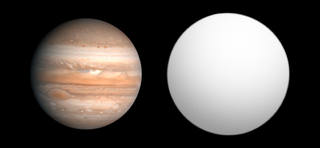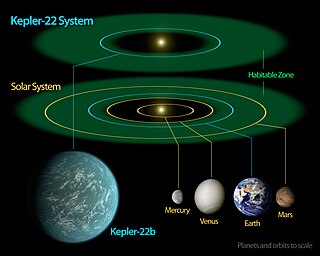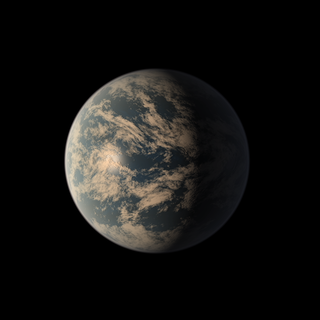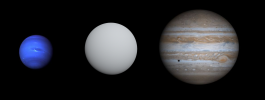
An exoplanet or extrasolar planet is a planet outside the Solar System. The first possible evidence of an exoplanet was noted in 1917 but was not then recognized as such. The first confirmed detection of an exoplanet was in 1992 around a pulsar, and the first detection around a main-sequence star was in 1995. A different planet, first detected in 1988, was confirmed in 2003. As of 24 January 2025, there are 5,830 confirmed exoplanets in 4,354 planetary systems, with 976 systems having more than one planet. In collaboration with ground-based and other space-based observatories the James Webb Space Telescope (JWST) is expected to give more insight into exoplanet traits, such as their composition, environmental conditions, and potential for life.

CoRoT was a space telescope mission which operated from 2006 to 2013. The mission's two objectives were to search for extrasolar planets with short orbital periods, particularly those of large terrestrial size, and to perform asteroseismology by measuring solar-like oscillations in stars. The mission was led by the French Space Agency (CNES) in conjunction with the European Space Agency (ESA) and other international partners.

HD 209458 b is an exoplanet that orbits the solar analog HD 209458 in the constellation Pegasus, some 157 light-years from the Solar System. The radius of the planet's orbit is 0.047 AU, or one-eighth the radius of Mercury's orbit. This small radius results in a year that is 3.5 Earth-days long and an estimated surface temperature of about 1,000 °C. Its mass is 220 times that of Earth and its volume is some 2.5 times greater than that of Jupiter. The high mass and volume of HD 209458 b indicate that it is a gas giant.

TrES-1b is an extrasolar planet approximately 523 light-years away in the constellation of Lyra. The planet's mass and radius indicate that it is a Jovian planet with a similar bulk composition to Jupiter. Unlike Jupiter, but similar to many other planets detected around other stars, TrES-1 is located very close to its star, and belongs to the class of planets known as hot Jupiters. The planet was discovered orbiting around GSC 02652-01324.

Any planet is an extremely faint light source compared to its parent star. For example, a star like the Sun is about a billion times as bright as the reflected light from any of the planets orbiting it. In addition to the intrinsic difficulty of detecting such a faint light source, the light from the parent star causes a glare that washes it out. For those reasons, very few of the exoplanets reported as of January 2024 have been observed directly, with even fewer being resolved from their host star.

Gliese 436 b is a Neptune-sized exoplanet orbiting the red dwarf Gliese 436. It was the first hot Neptune discovered with certainty and was among the smallest-known transiting planets in mass and radius, until the much smaller Kepler exoplanet discoveries began circa 2010.

HD 189733 b is an exoplanet in the constellation of Vulpecula approximately 64.5 light-years away from the Solar System. Astronomers in France discovered the planet orbiting the star HD 189733 on October 5, 2005, by observing its transit across the star's face. With a mass 11.2% higher than that of Jupiter and a radius 11.4% greater, HD 189733 b orbits its host star once every 2.2 days at an orbital speed of 152.0 kilometers per second, making it a hot Jupiter with poor prospects for extraterrestrial life.

WASP-12b is a hot Jupiter orbiting the star WASP-12, discovered in April of 2008, by the SuperWASP planetary transit survey. The planet takes only a little over one Earth day to orbit its star, in contrast to about 365.25 days for the Earth to orbit the Sun. Its distance from the star is only the Earth's distance from the Sun, with an eccentricity the same as Jupiter's. Consequently, it has one of the lowest densities for exoplanets. On December 3, 2013, scientists working with the Hubble Space Telescope (HST) reported detecting water in the atmosphere of the exoplanet. In July 2014, NASA announced finding very dry atmospheres on three exoplanets orbiting sun-like stars.

CoRoT-7b is an exoplanet orbiting the star CoRoT-7 in the constellation of Monoceros, 489 light-years from Earth. It was first detected photometrically by the French-led CoRoT mission and reported in February 2009. Until the announcement of Kepler-10b in January 2011, it was the smallest exoplanet to have its diameter measured, at 1.58 times that of the Earth and the first potential extrasolar terrestrial planet to be found. The exoplanet has a very short orbital period, revolving around its host star in about 20 hours.

Kepler-7b is one of the first five exoplanets to be confirmed by NASA's Kepler spacecraft, and was confirmed during the first 34 days of Kepler's science operations. It orbits a star slightly hotter and significantly larger than the Sun that is expected to soon reach the end of the main sequence. Kepler-7b is a hot Jupiter that is about half the mass of Jupiter, but is nearly 1.5 times its size; at the time of its discovery, Kepler-7b was the second most diffuse planet known, surpassed only by WASP-17b. It orbits its host star every five days at a distance of approximately 0.06 AU. Kepler-7b was announced at a meeting of the American Astronomical Society on January 4, 2010. It is the first extrasolar planet to have a crude map of cloud coverage.

Kepler-6b is an extrasolar planet in the orbit of the unusually metal-rich Kepler-6, a star in the field of view of the NASA-operated Kepler spacecraft, which searches for planets that cross directly in front of, or transit, their host stars. It was the third planet to be discovered by Kepler. Kepler-6 orbits its host star every three days from a distance of .046 AU. Its proximity to Kepler-6 inflated the planet, about two-thirds the mass of Jupiter, to slightly larger than Jupiter's size and greatly heated its atmosphere.

An exoplanet is a planet located outside the Solar System. The first evidence of an exoplanet was noted as early as 1917, but was not recognized as such until 2016; no planet discovery has yet come from that evidence. What turned out to be the first detection of an exoplanet was published among a list of possible candidates in 1988, though not confirmed until 2003. The first confirmed detection came in 1992, with the discovery of terrestrial-mass planets orbiting the pulsar PSR B1257+12. The first confirmation of an exoplanet orbiting a main-sequence star was made in 1995, when a giant planet was found in a four-day orbit around the nearby star 51 Pegasi. Some exoplanets have been imaged directly by telescopes, but the vast majority have been detected through indirect methods, such as the transit method and the radial-velocity method. As of 24 July 2024, there are 7,026 confirmed exoplanets in 4,949 planetary systems, with 1007 systems having more than one planet. This is a list of the most notable discoveries.

Kepler-22b is an exoplanet orbiting within the habitable zone of the Sun-like star Kepler-22. It is located about 640 light-years from Earth in the constellation of Cygnus. It was discovered by NASA's Kepler Space Telescope in December 2011 and was the first known transiting planet to orbit within the habitable zone of a Sun-like star, where liquid water could exist on the planet's surface. Kepler-22 is too dim to be seen with the naked eye.

The Next-Generation Transit Survey (NGTS) is a ground-based robotic search for exoplanets. The facility is located at Paranal Observatory in the Atacama Desert in northern Chile, about 2 km from ESO's Very Large Telescope and 0.5 km from the VISTA Survey Telescope. Science operations began in early 2015. The astronomical survey is managed by a consortium of seven European universities and other academic institutions from Chile, Germany, Switzerland, and the United Kingdom. Prototypes of the array were tested in 2009 and 2010 on La Palma, and from 2012 to 2014 at Geneva Observatory.

TRAPPIST-1d is a small exoplanet, which orbits on the inner edge of the habitable zone of the ultracool dwarf star TRAPPIST-1, located 40.7 light-years away from Earth in the constellation of Aquarius. The exoplanet was found by using the transit method. The first signs of the planet were announced in 2016, but it was not until the following years that more information concerning the probable nature of the planet was obtained. TRAPPIST-1d is the second-least massive planet of the system and is likely to have a compact hydrogen-poor atmosphere similar to Venus, Earth, or Mars. It receives just 4.3% more sunlight than Earth, placing it on the inner edge of the habitable zone. It has about <5% of its mass as a volatile layer, which could consist of atmosphere, oceans, and/or ice layers. A 2018 study by the University of Washington concluded that TRAPPIST-1d might be a Venus-like exoplanet with an uninhabitable atmosphere. The planet is an eyeball planet candidate.

TRAPPIST-1c, also designated as 2MASS J23062928-0502285 c, is a mainly rocky exoplanet orbiting around the ultracool dwarf star TRAPPIST-1, located 40.7 light-years (12.5 parsecs) away from Earth in the constellation Aquarius. It is the third most massive and third largest planet of the system, with about 131% the mass and 110% the radius of Earth. Its density indicates a primarily rocky composition, and observations by the James Webb Space Telescope announced in 2023 suggests against a thick CO2 atmosphere, however this does not exclude a thick abiotic oxygen-dominated atmosphere as is hypothesized to be common around red dwarf stars.

TRAPPIST-1f, also designated as 2MASS J23062928-0502285 f, is an exoplanet, likely rocky, orbiting within the habitable zone around the ultracool dwarf star TRAPPIST-1, located 40.7 light-years away from Earth in the constellation of Aquarius. The exoplanet was found by using the transit method, in which the dimming effect that a planet causes as it crosses in front of its star is measured.

TRAPPIST-1e, also designated as 2MASS J23062928-0502285 e, is a rocky, close-to-Earth-sized exoplanet orbiting within the habitable zone around the ultracool dwarf star TRAPPIST-1, located 40.7 light-years away from Earth in the constellation of Aquarius. Astronomers used the transit method to find the exoplanet, a method that measures the dimming of a star when a planet crosses in front of it.

CoRoT-8b is a transiting exoplanet orbiting the K-type main sequence star CoRoT-8 1,050 light years away in the equatorial constellation Aquila. The planet was discovered in April 2010 by the CoRoT telescope.
Kepler-167 is a K-type main-sequence star located about 1,119 light-years (343 pc) away from the Solar System in the constellation of Cygnus. The star has about 78% the mass and 75% the radius of the Sun, and a temperature of 4,884 K. It hosts a system of four known exoplanets. There is also a companion red dwarf star at a separation of about 700 AU, with an estimated orbital period of over 15,000 years.




















